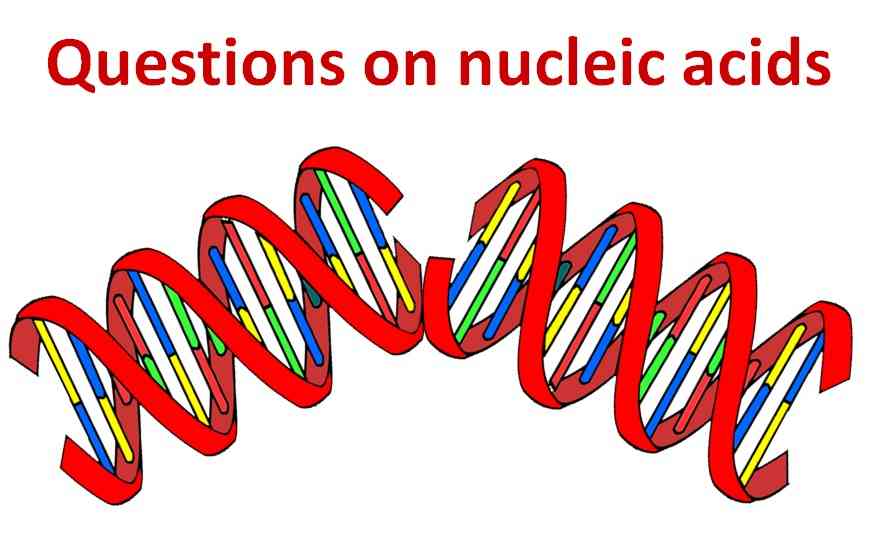
1. What is common in all of them i.e. NAD, FAD, NADP, ATP
A. Adenine
B. Phosphate
C. Ribose
D. All of these
Answer: D (All of these)
2. The carbon atoms of the pentose sugar involved in phosphodiester bond formation in DNA and RNA are:
A. C1 and C5
B. C2 and C3
C. C3 and C5
D. C4 and C5
Answer: C (C3 and C5)
3. B-DNA which is a right-handed double helix that contains _ base pairs per turn of the helix and each turn is _ long?
A. 10, 3.4 Å
B. 10, 34 Å
C. 11, 20 Å
D. 11, 34 Å
Answer: B (10, 34 Å)
4. Which of the following is only a ribose nucleotide?
A. Cytosine – pentose Sugar – Phosphate
B. Guanine – pentose Sugar – Phosphate
C. Thymine – pentose Sugar – Phosphate
D. Uracil – pentose sugar – Phosphate
Answer: D (Uracil – pentose sugar – Phosphate)
5. Chargaff, in his experiments on the chemistry of DNA, estimated the base composition of human DNA and found adenine constitutes 31% and guanine 19%. The quality of cytosine in the DNA of a human somatic cell is likely to be?
A. 31%
B. 19%
C. 62%
D. 38%
Answer: B (19%).
6. Which of the following sequence is correct based on increasing molecular weight?
A. DNA, ATP, NADP, AMP
B. AMP, ATP, NADP, DNA
C. ATP, AMP, DNA, NADP
D. ATP, ADP, NADP, DNA
Answer: B (AMP, ATP, NADP, DNA).
7. A unit composed of sugar and nitrogen base linked by the glycosidic bond is
A. Glycoside
B. Nucleoside
C. Nucleotide
D. Purine
Answer: B (Nucleoside)
8. Nicotinamide can be synthesized in a human body from
A. Fructose
B. Lactose
C. Tyrosine
D. Tryptophan
Answer: D (Tryptophan)
9. Which of the following is a nucleotide?
A. Adenylic acid
B. Adenosine
C. RNA
D. Adenine
Answer: A (Adenylic acid).
10. Cytochromes are
A. Riboflavin nucleotides
B. Pyrimidine nucleotides
C. Iron porphyrin protein
D. Flavoprotein
Answer: C (Iron porphyrin protein).
11. On hydrolysis a nucleoside would not yield
A. Phosphoric acid
B. Purine
C. Pyrimidine
D. Pentose sugar
Answer: A (Phosphoric acid)
12. t-RNA is also known as?
A. Messenger RNA
B. rRNA
C. Microsomal RNA
D. Soluble RNA
Answer: D (Soluble RNA).
13. The most RNA in the cell is:
A. rRNA
B. sRNA
C. tRNA
D. mRNA
Answer: A (rRNA)
14. Nucleic acid was discovered as nuclein by:
A. Miescher
B. Koch
C. Altmann
D. Flemming
Answer: A (Miescher).
15. The type of RNA that characteristically contains methylated purines and pyrimidines is:
A. tRNA
B. mRNA
C. rRNA
D. All of above
Answer: B (mRNA).
16. The maximum formation of mRNA occurs in:
A. Cytoplasm
B. Nucleolus
C. Ribosomes
D. Nucleus
Answer: B (Nucleolus).
17. RNA responsible for directing the proper sequence of amino acids in protein synthesis is:
A. Chromosomal RNA
B. Ribosomal RNA
C. Transfer RNA
D. Messenger RNA
Answer: D (Messenger RNA).
18. Nitrogenous base ‘Choline’ is present with
A. Lecithin
B. Cephalin
C. Both (1) and (2)
D. None of these
Answer: A (Lecithin).
19. Number of nitrogen bases in a single strand of B-DNA with 100 turns is
A. 500
B. 1000
C. 2000
D. 250
Answer: B (1000).
Other important questions:
Q. The alpha-helix and beta-sheet are found at which level of protein organization?
Q. Which cytoskeletal proteins provide the structural support for microvilli?
Q. Which of these does not contain a structural protein?
Q. What level of protein structure is associated with the sequence of amino acids?
Q. Which of the following pertains to typhoid fever?
Q. Which of the following tests is an agglutination test for the bacterium causing typhoid fever?










